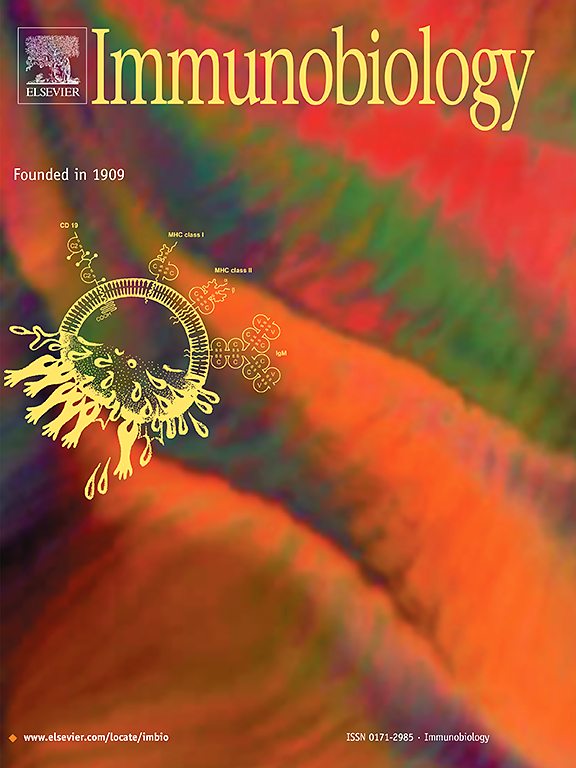Advanced glycation end products induce autophagy in endothelial cells through oxidative stress and regulation of the RhoA-mTOR signaling pathway
IF 2.3
4区 医学
Q3 IMMUNOLOGY
引用次数: 0
Abstract
Background
Advanced glycation end product (AGE)-induced oxidative stress in human umbilical vein endothelial cells (HUVECs) is closely associated with the miR-200b-RhoA signaling axis. Rho-associated protein kinase (RhoA) can crosstalk with the mammalian target of rapamycin (mTOR) complex 1. This study investigated the role of the RhoA-mTOR signaling pathway in autophagy induced in HUVECs by AGEs. In the present study, more severe oxidative damage was found in the HUVECs with AGE-induced autophagy.
Methods
We set 5 different concentrations and times respectively, by comparing the cell proliferation changes at different intervention concentrations at each intervention time point and calculating the oxidative stress indicators at four time points, we found that 200 μg/L AGEs intervention for 6 h is the best concentration and time. The expression of RhoA, ROCK, and mTOR was decreased after AGE stimulation, and increased after inhibition of RhoA. Further, we constructed two retroviral plasmids to express constitutively active (Q63LRhoA) or loss-of-function (T19NRhoA) RhoA, and obtained stably transfected HUVECs.
Results
There was a statistically significant difference in mTOR mRNA expression between Q63LRhoA and T19NRhoA cells. In summary, AGEs induced oxidative damage and autophagy in HUVECs, which may be related to synchronous regulation of the RhoA-mTOR signaling pathway.
晚期糖基化终产物通过氧化应激和RhoA-mTOR信号通路调控诱导内皮细胞自噬
人脐静脉内皮细胞(HUVECs)中晚期糖基化终产物(AGE)诱导的氧化应激与miR-200b-RhoA信号轴密切相关。RhoA相关蛋白激酶(RhoA)可以与哺乳动物雷帕霉素(mTOR)复合物1靶点串扰。本研究探讨了RhoA-mTOR信号通路在AGEs诱导HUVECs自噬中的作用。在本研究中,在年龄诱导的自噬huvec中发现更严重的氧化损伤。方法分别设置5个不同的浓度和时间,通过比较不同干预浓度在每个干预时间点的细胞增殖变化,计算4个时间点的氧化应激指标,发现200 μg/L AGEs干预6 h为最佳浓度和时间。RhoA、ROCK和mTOR的表达在AGE刺激后降低,在RhoA抑制后升高。此外,我们构建了两个逆转录病毒质粒来表达组成性活性(Q63LRhoA)或功能丧失(T19NRhoA) RhoA,并获得了稳定转染的HUVECs。结果Q63LRhoA细胞与T19NRhoA细胞mTOR mRNA表达差异有统计学意义。综上所述,AGEs诱导HUVECs氧化损伤和自噬,这可能与RhoA-mTOR信号通路的同步调控有关。
本文章由计算机程序翻译,如有差异,请以英文原文为准。
求助全文
约1分钟内获得全文
求助全文
来源期刊

Immunobiology
医学-免疫学
CiteScore
5.00
自引率
3.60%
发文量
108
审稿时长
55 days
期刊介绍:
Immunobiology is a peer-reviewed journal that publishes highly innovative research approaches for a wide range of immunological subjects, including
• Innate Immunity,
• Adaptive Immunity,
• Complement Biology,
• Macrophage and Dendritic Cell Biology,
• Parasite Immunology,
• Tumour Immunology,
• Clinical Immunology,
• Immunogenetics,
• Immunotherapy and
• Immunopathology of infectious, allergic and autoimmune disease.
 求助内容:
求助内容: 应助结果提醒方式:
应助结果提醒方式:


